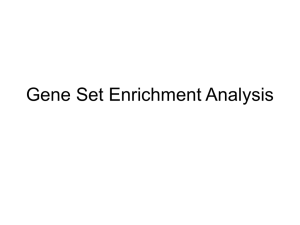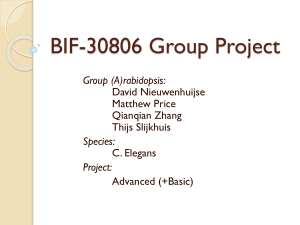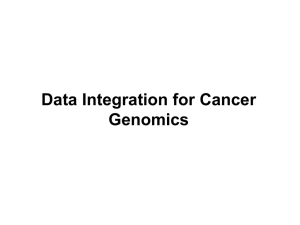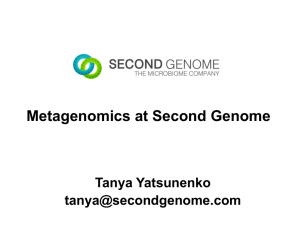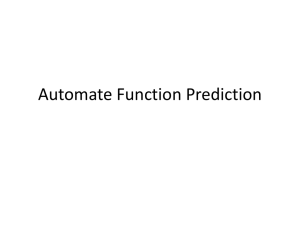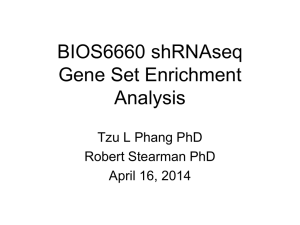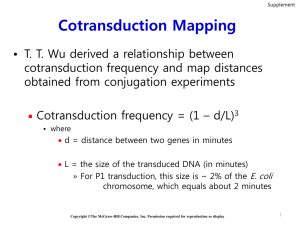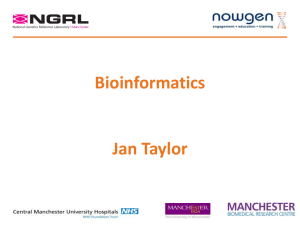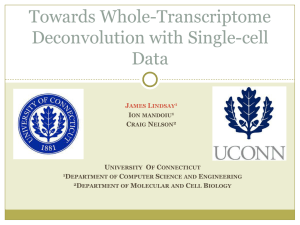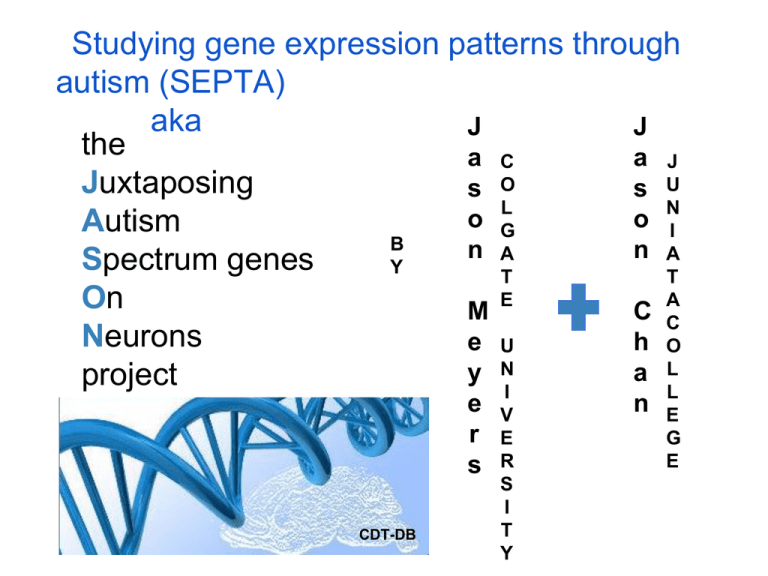
Studying gene expression patterns through
autism (SEPTA)
aka
J
J
the
a C
a J
Juxtaposing
s O
s U
L
N
o
o
Autism
G
I
B
n A
n A
Spectrum genes
Y
T
T
E
A
On
M
C C
Neurons
e U
h O
y N
a L
project
I
L
e
r
s
CDT-DB
V
E
R
S
I
T
Y
n
E
G
E
Background:
The genetic changes that underlie autism are not well understood.
Many studies have implicated changes in the cerebellum with
autism, and many of the candidate autism genes are expressed in
the cerebellum. As one example, RORa (retinoic acid receptorrelated orphan receptor alpha) is reduced in autism patients. When
this gene is missing in mouse mutants, it leads to cognitive and
motor defects. This problem space explores RORa expression in the
cerebellum to help make predictions about the disease, and other
genes that might interact with RORA.
Dataset:
The problem space uses the The Cerebellar Development
Transcriptome Database (http://www.cdtdb.neuroinf.jp) from the
Neuroinformatics Japan Center and the RIKEN-Brain Science Institute
in Japan.
Additional supplemental datasets from Gold et al. (2003) and
Sarachana et al., (2013), AutDB, AutismKB, etc.
Project Goals:
•
•
•
•
•
•
Understand that gene expression varies in
space and time
Compare methods for reporting gene
expression
To analyze graphical data and biological
images
Think about what types of data are useful in
determining candidate genes for a disease state
Teach students how to work with large multifactorial databases
Help prospect for autism candidate genes
Target audience:
•
Introductory biology:
o
•
•
o
Upper level Neuroscience
Upper level Development
o
o
•
Biological examples of gene regulation varying across space
and time
Determining which genes might work together in a network
o
Relationship of particular gene functions to disease states
Exploration of transcriptomes
Identifying new candidate disease genes
Biotechniques labs
o
o
Overview of different mRNA expression techniques
Data, graph, and image analysis
staggerer mice as a model
Cerebellum
Wild Type brain
Cerebellum
staggerer brain
Adapted from Sidman et al. (1962)
staggerer mice have a very small
cerebellum, and poor motor coordination,
hence their characteristic staggering
behavior that gives them their name.
(Sidman et al., 1962). The causative
mutation is in the Rora gene (Hamilton et
al., 1996; Steinmayer et al., 1998), which is
an orphan retinoic acid receptor. This
family of nuclear receptor acts to regulate
gene expression of various other genes.
This exercise allows you to explore gene
regulation in silico by analyzing large
datasets of gene expression.
Tool: The Cerebellum Development
Transcriptome Database (CDT-DB)
The database collects data from measuring mRNA quantity in regionspecific mouse brain tissues during different stages of development.
It uses four techniques:
o GeneChip
o RT-PCR
o custom arrays
o In situ hybridization (ISH)
Benefits of CDT-DB
o Robust Temporal and Spatial Expression
o Gene Ontology and Neuroanatomical classification
o Gene search utility to compare many genes by adding them to personalized lists
(My List)
For example, mutants with cerebellar disorders can be grouped and examined together:
Reln, Rora, Kcnj6, Grid2
Activity 1: Comparison of methods for studying gene
expression
1. Identify the expression pattern of a specific gene
- on ctdtb homepage, enter gene (Rora) in Gene Name &
Keyword Search to search
2. Your search will lead you to a list, where you can select links
to get more information about your gene of interest, including:
- gene information
- temporal gene expression
- spatial gene expression
- tissue expression
- category (gene ontology)
3. Compare and contrast RORa (staggerer) expression
using different techniques
Questions
•
•
•
•
How do these different types of analysis of
gene expression data compare?
How would you describe the expression of
RORa? What trends do you see?
What additional information would you like to
see?
How might you compare RORa to other
candidate autism genes?
Activity 2: Predicting co-regulated genes by
comparison of multiple expression patterns
To compare multiple genes, enter gene into Gene Search and
add them individually to "My Lists." For this exercise,
examine four genes that are linked with mouse cerebellar
dysgenesis: RORa (staggerer), Reelin (reeler), Kcnj6
(weaver), Grid2 (Lurcher)
Use this to generate a
single graph comparing
the GeneChip data for all
of the genes
Examine the spatial
expression domains of
each of these genes
To what categories do
these genes belong?
What functions might they
have?
Reelin (reeler)
Grid2 (Lurcher)
Kcnj6 (weaver)
RORa (staggerer)
Questions
•
•
•
How would you group these genes? What criteria are
important for trying to group the genes?
What biological hypotheses might stem from your
clustering of genes?
How can you determine whether genes may be
regulating one another or may be co-regulated?
Challenge Question:
The Lurcher mouse is a dominant gene, but curiously,
mice double mutant for both Lurcher and staggerer do
not show the Lurcher phenotype (Messer et al., 1991).
Hypothesize why this may be.
•
Expression of Grid2 in staggerer
(RORa) mutant mice:
Data from Messer and Kang (2000)
Prospecting for Genes Related to
Autism Spectrum Disorders
As described earlier, the molecular basis for autism
is unclear. RORa, which we have seen is a
selectively expressed transcription factor in a
subset of neurons in the cerebellum (Purkinje
Cells), is an autism candidate gene, as it shows
reduced expression in autism patients (Nguyen et
al., 2010; Sarachana et al., 2011). Since RORa is
a transcription factor, changes in its expression
likely alter expression of other genes.
What would you predict should happen in autism
patients for genes that RORa positively/negatively
regulates?
Prospecting for Genes Related to
Autism Spectrum Disorders
You will now be using your skills at analyzing gene
expression to look through data to find likely
candidate genes that may be regulated by
RORa and thus may be related to cerebellar
problems and/or autism.
You will have access to two datasets:
1. Genes found to be up-/down-regulated in
RORa (staggerer) mutant mice
2. Genes that have a sequence upstream that
RORa binds to in vitro.
Design:
Which dataset(s) will you use? What
information in them is most relevant?
Given the information you can obtain from the
CDT database, what information might you
be able to add to help determine whether a
gene may be a good candidate for regulation
by RORa?
Gene expression altered in
staggerer mice (Gold et al., 2003)
Probe ID
Gene
ANOVA F
p Value
Min. Fold-Change E15 and
E17
F × Fold-Change
X61397_s_at
Cals1
157.378
0
4.25
668.86
M21532_s_at
Pcp2
116.929
0
2
233.86
M21531_s_at
Calb1
73.531
0
2.25
165.44
U44725_s_at
Kitl
48.147
0
3
144.44
D83262_at
Slc1a6 (EAAT4)
18.462
0.0015
3.25
60
AA415606_at
Baf53a
43.954
0
1.25
54.94
X17320_s_at
Pcp4
33.003
0.0002
1.25
41.25
AF026489_at
Spnb3
29.314
0.0003
1.25
36.64
AA267955_s_at
ESTs<comma> weakly
similar to retinoblastomaassociated protein HEC
25.684
0.0005
1.25
32.1
Msa.1693.0_s_at
Idb2
20.554
0.0011
1.5
30.83
AA426917_s_at
Ccnb1-rs1
22.25
0.0008
1.25
27.81
X56044_s_at
Htf9c
5.674
0.0385
4.5
25.53
Msa.17592.0_s_at
pigpen protein
19.534
0.0013
1.25
24.42
Z26580_s_at
Ccna2
16.353
0.0024
1.25
20.44
AA408677_rc_s_at
Txnrd1
14.784
0.0032
1.25
18.48
Decreased Expression
Study compared
gene expression at
E15 and E17 in
wild-type and
staggerer mice.
The minimum foldchange between
wild-type and
staggerer mice is
shown in the fifth
column.
Candidate genes regulated by
RORa (Sarachana and Hu, 2013)
Nearest Gene
MAT-score on T
p-value (region)
(
region)
PPP2R2B
68.92
3.25E-04
DDX52
59.33
4.83E-04
CBX3
51.22
6.15E-04
UGT2B15
49.47
6.33E-04
UGT2B17
46.29
7.03E-04
LYPLA1
41.07
8.52E-04
TPD52L2
41.06
8.52E-04
CYP2R1
40.90
8.52E-04
ARPC4
39.69
8.88E-04
HSD17B10
39.13
8.88E-04
BCL11B
38.67
9.40E-04
HK1
37.16
9.93E-04
ABCC8
34.22
1.19E-03
ABHD4
33.26
1.20E-03
PTPN11
32.71
1.24E-03
LRRC7
32.41
1.26E-03
HECW1
31.52
1.36E-03
This study used ChIPchip to find regions
of the chromosomes
to which the RORa
protein binds. Top
candidates are
shown to the left.
Additional potential datasets:
AutDB:
http://autism.mindspec.org/autdb/Welcome.do
AutismKB:
http://autismkb.cbi.pku.edu.cn/
Other activities
- Examine the expression patterns of candidate genes
involved with Autism Spectrum Disorder
- students can use the datasets introduced in the
previous slides or students can do their own research on
genes they think might be involved with the disorder.
- see list on next slide for a list of genes from the
Sarachana T and Hu VW. (2013) dataset.
Other quantitative analyses
- Cluster analysis of groups of genes
From
Sarachana T
and Hu VW.
(2013)
Select GeneChip
graph to
compare all, as
shown on the
next slide
(2013)
Which of these might be good candidates?
What additional information would you want to
see?
Non-Autism related activities
The CDT-DB has more utility beyond examining the
interactions between known genes of interest. It can be
used to data mine for other cell and developmental
biology questions.
- Examine genes that have similar gene ontology-classified functions, and
predict their interactions
- Examine genes that have similar expression patterns (e.g. genes with peak
expressions at P7), compare their spatial expression patterns, and predict
their interactions
- Examine genes that are expressed in a specific cell type in the cerebellum,
identify genes that have similar spatial or temporal expression patterns, and
predict their interactions
To examine genes that have similar gene ontologyclassified functions, and predict their interactions
1. click here (category)
2. click here for a full list of transcription
factors
3. click here for a graph allowing you to
examine the expression patterns of multiple
transcription factors
Questions:
Which transcription factors are likely to act together, and how can you tell?
Using the Gene Expression Search menu (link on the homepage), expression
data can be found by cell type, expression profile, spatial expression, brain
distribution, and brain specificity.
Example
Searching all brain dominant genes whose expression is
going up during P21 of cerebellar development will give
you 206 genes. Their GeneChip Graph is shown here.
From here, individual or multiple genes
can be isolated and compared. Then,
using the
utility, spatial
expressions can be compared to predict
whether they act in the same cell types,
at the same time.
Questions:
- Which genes match very closely, and
do their spatial expressions match?
- If they do, does that mean they interact
and how can you test for that?
- Using other search strings, can you tell
what the primary functions of a particular
cell type are?
References and Resources
1. Cerebellum development transcriptome database website (http://www.cdtdb.neuroinf.jp/CDT/Top.jsp)
- CDT-DB user guide: http://www.cdtdb.neuroinf.jp/CDT/Download.do
2. Sarachana T and Hu VW (2013) Genome-wide identification of transcriptional targets of RORA reveals direct
regulation of multiple genes associated with autism spectrum disorder. Mol Autism. May 22;4(1):14.
3. Gold DA, Gent PM, Hamilton BA (2007) RORα in genetic control of cerebellum development: 50 staggering years.
Brain Research. Volume 1140, 6 April 2007, Pages 19–25
4. Messer A, Eisenberg B, Plummer J (1991) The Lurcher cerebellar mutant phenotype is not expressed on a staggerer
mutant background. J Neurosci, 11: 2295-2302.
5. Messer A and Kang X (2000) Control of transcription in the RORa-staggerer mutant mouse cerebellum: glutamate
receptor delta2 mRNA Int J Dev Neurosci, 18: 663-668.
6. Sarachana T, Xu M, Wu R-C, Hu VW (2011)
Sex Hormones in Autism: Androgens and Estrogens Differentially
and Reciprocally Regulate RORA, a Novel Candidate Gene for Autism. PLoSOne. 6:e17116.
7. Sidman, R. L., Lane, P. W., and Dickie, M. M. (1962). Staggerer, a new mutation in the mouse affecting the
cerebellum. Science, 137, 610–2.


